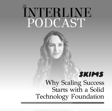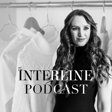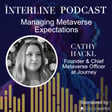Become a Creator today!Start creating today - Share your story with the world!
Start for free
00:00:00
00:00:01

Talking Sustainability, Innovation, and Cooperation with Munich Fabric Start
For this episode, Emma is joined by two of the team from Munich Fabric Start: Claudia Mynott, Marketing and Communications Director, and Simon Angel, Sustainable Innovations Curator.
Together they talk about:
- What the driving principles of the MFS show are today and what is important for live events to offer in the current climate.
- Whether the role of technology has changed over the years with the development of digital product creation, AI, and also the tightening regulations around sustainability.
- How the sourcing landscape might shift in the near future.
Find out more about the team's next event in Munich on the 21st and 22nd of January 2025 at: https://www.munichfabricstart.com/en/
Transcript
Collaboration's Role in Fashion Innovation
00:00:06
Speaker
My first advice would be, and maybe that comes from ah from my German background, and open up and work together. So here we have to join forces because when we open up with a challenge, with a problem to somebody else and take their advice and then it leads to maybe the next partner. And so we are trying then to use force ah to to use expertise and also know-how that we as a single person don't have. And together we can really change something. Be courageous, do the trial and error, and then move forward. It's only in in these kind of steps that we can achieve the change.
Introduction to Hosts and Guests
00:00:54
Speaker
Hey, everybody. Ben here, the Interlines Editor-in-Chief, and a voice you might be used to hearing if you've been a long-time listener. Emma's away at the moment, so I'm stepping back up to the host microphone briefly to do the introduction to this episode, although you're still going to hear Emma doing the actual interviewing. We're delighted to have two guests on the show today from Munich Fabric Start, one of the leading textile trade shows in Europe. Claudian Minot, who is the Marketing and Communications Director there, and Simon Engel, who serves as Sustainable Innovations Curator. Now, both Munich Fabrik Start and the Interline agree that one of the biggest challenges facing fashion today is finding ways to reduce its environmental and social impact without compromising its core creative essence. And in pursuit of this, Munich Fabrik Start actually supported the Interline's recent 2024 sustainability report. That report took a deep dive into the developing role that tech solutions are playing in changing the sustainability profile of fashion, and it looked at how far the industry still has to travel. And you can, of course, download that report for free from The Interline right now. It's packed with unique stories told by industry figures. It's contained some key insights into how leading tech companies are building the infrastructure and the experiences that fashion urgently needs, it has some market analysis, and there's a foreword in there for Munich Fabric Start's own Sebastian Klinder.
Tradition vs. Technology in Fashion
00:02:15
Speaker
Now in this episode you're going to hear Claudia, Simon and Emma discussing what the driving principles of the Munich Fabric Start show are today, and they're going to talk about what it's important for live events to offer in the current climate. They'll also discuss whether the role of tech has changed over the years with the development of digital product creation, or DPC as we dub it, AI, um and how the tightening regulations around sustainability are changing and how the sourcing landscape might shift in the near future. Another big topic they're going to touch on is one that Munich Fabric Start and the Interline have explored together in the past, and that's the idea that tradition and technology seem maybe to be antithetical. But in today's fashion world, the two can complement each other and they can serve as mutual sources of inspiration and creativity. Emma, Claudia and Simon are going to discuss the creative possibilities of AI. They're going to contrast the vulnerability and the strength of the fashion industry in uncertain times. They're going to look at the return of some key principles of sharpness, power and glamour. And they're going to talk about how every stakeholder in the fashion industry needs to act in these times of volatility and difficulty, especially when it comes to blending sustainability and technology. So let's get started. And to do that, I'm going to hand you over to Emma's conversation with Claudia and Simon. Good morning to Claudia Meinert and Simone Engel of Munich Fabric Start. We are delighted to have you here on the Interline podcast. um Welcome to the show and um can't wait to to speak with you on um the questions that we've prepared and to get your insights. Welcome. Thank you. Thank you so much, Anna. Good morning. Good morning.
Sustainable Practices in Textiles
00:04:01
Speaker
Good
00:04:03
Speaker
first start ah sim on with you and i want to ask you both this question can you start by telling me ah little bit about your careers and how you came to work with muni fabric starts so simon will start with you if that's okay well that's a very tricky question from my perspective because I work on different kind of fields within the cultural sector. and um But I think for now, for this podcast, morning. you are referring to my textile slash fashion background. So um I collaborated on ah on a sustainable women's ah fashion label. And from that perspective, I i think I studied the the value chain of sustainable topics within being a women's label. um And then from that expertise, when I studied the the whole chain of the textile industry, then um I had some ah people in my network suggested that I should be working more on textiles because somewhere, somehow I'm looking at textiles as a whole, from a holistic perspective. so And from that side, ah from that ah um from that perspective, I got in contact with Claudia ah with the Munich Fabric Start. And um obviously um from the fashion industry, I had a lot of, I have a very broad network. I know a lot of people from a teaching perspective as well. um Yeah, and then, yeah, Claudia and I started talking and had in a conversation and thought, well, maybe it would make sense that from a curating perspective, we could collaborate or something. and How we started working together is that we initiated our Innovation Hub Keyhouse at the Munich Fabrik Start in 2016.
Munich Fabric Start's Mission and Values
00:06:10
Speaker
And within this Innovation Hub, we were looking for an to create an area where we can showcase new material resources, very innovative approaches that are future oriented, be it material wise-wise, be it process-wise, be it color-wise, finishing. And ah for that, we looked for a curator. And that is how we approached Simon. And this collaboration is now ongoing already for almost nine years. It's turning nine years in January. Oh, no, that's great. And that's, it's really nice to work with people for such a long time in this industry, I feel that that's really important, actually, for building and for growth and and everything. So that's fantastic. Absolutely agree, Emma, yes. And Claudia, now that um we've we've got you um you, you spoke last, but I'd like to ask you a little bit more about the show. um What would you say are the driving principles of Munich Fabric Start today? And what do you think is important for live events to offer in the current climate of fashion and retail and textiles and sustainability? Yeah, that's an interesting question. um I think the driving principles of our show today do not really differ from our driving principles when the show was founded in 1996. We started back then as a family-owned business and with 50 exhibitors and since then developed in an organical way to about 1,000 exhibitors, international suppliers from the fashion industry and that showcase all ingredients a fashion collection has to be in Munich twice a year. And what the driving principle behind this is really to provide a platform. We see ourselves as hosts, as service provider for the entire fashion industry. And um we develop further together with the market. So in that environment for live events nowadays, it's very important to provide a platform where business can be done. We do that with excellent services aside to have a very atmospheric, very ambient and very nice environment to work. We foster personal exchange. We we really enrich cooperation. So we try to bring the right right partners together to meet in Munich and then to find themselves in evolving ideas and ideas turn into concrete actions. And and that way we support the change in the industry that is needed. But one important value is also trust. So especially in the current climate, um people need to trust in and platforms like ours. So people, when they come to Munich, they know what to expect, they know where to find the things they're looking for. So that is kind of a continuity that we provide. And one other important thing is flexibility. So so um flexibility to adapt to the developments in our business organization really allows to, so we can move and change really fast and adapt to the ever-needing market very quick. And that is also some kind of essential
00:09:44
Speaker
in in today's context i would say definitely and we've worked together quite a fair bit and i always love the steams that munich fabric dot comes up with i think it's um really original and um i speak a little bit about or you've you've actually spoken about trust and ah this year I believe in in January, you spoke about this contrast of vulnerability and in today's context, strength and the return of sharpness, power and glamour. um And I really think those themes make what you're talking about really um accessible to people um in the industry to understand and then apply there with their knowledge and where they're coming from, um especially in this new world of, like we were talking about, and sustainability and technology and all of this. I think that um you know Fabric Start is such a great platform for collaboration and a meeting of minds. um So would you add anything to that? Or Simon, do you want to comment on anything from that perspective, especially when it comes to technology and innovation?
Technology's Evolution in Fashion
00:10:52
Speaker
Well, yeah, if I overhear your question, then I think there are different kinds of perspectives that you are mentioning. And I think from the value side, I can strongly relate and feel the strength of of somehow, somewhere, the family values in a way. um And I can relate to that very strongly. So all of the topics that Claudia mentioned about reliability and about trust and about shared responsibility, I think this is part of the success of um of collaborate with such a party as the Munich Fabrikstad itself. So this is what keeps me very strongly related to ah to the industry and very motivated and also very, yeah, I think i i definitely feel the shared responsibility to take to take the industry further from this kind of field. So and this is what I try to do. and This was the second part of your question. I think that this is what but what I or we try to do with the sustainable innovations as well. that um ah when When people approach the sustainable innovations area, I always say, well, we are not we we are not selling anything. We are telling about we are telling stories and we make ah strong connections. So I think this is the part that um that's that' yeah when they're when we start a dialogue, then the dialogue is actually making sense and inviting parties on starting a collaboration or making each other stronger or inspiring each other. Yes, definitely. I think sometimes we talk a lot about, well, in your positions and also in mine, we talk a lot about technology. We talk a lot about sustainability and innovation. And these are words that mean a lot, but also they need some grounding. So that's why I find with the themes that that we've just mentioned, um I think it's really helpful because it puts everything into perspective and these values bring us back down to actually changing um these sort of buzzwords into meaningful action so uh absolutely yeah so so if you if you so if you're if i hear you say uh acknowledging this then i think this is what i what I strongly feel, for example, when when I'm in Munich and you see all of the participants and you see the audiences, then more and more I have the feeling that um the attention that you have for each other, for each each product and for each developments and for each worries and for each concerns, then when you actually share this attention and and and have a conversation on this, then you have yeah you all feel that you're in the same boat and you all have to do something to create a really strong chain. And I think this is a very important difference that I feel for years now and we are working on this for years as well and and I think it's really paying off starts to pay off in a way yeah I totally agree so the role of technology has changed a few years back it was ah mostly to create like wearables or fancy stuff that kind of had an entertaining role. And now it really um is used to create concrete solutions to the challenges that we face in the industry. And ah by working together, by really opening up on those challenges and problems that that one has in its company and then find the right partner, technology can really be adapted and used and, yeah, maybe be streamlined into the right direction. Yeah. And I think I don't want to, maybe I want to add something that that what I also like the approach is that that you can think on technology on a high-tech perspective. So ah robotics and AI, but you also can relate to low-tech approaches. and So really going back to nature and really going back to craftsmanship as well. So there is ah there's a really good marriage between high tech and low tech from this point. That's a nice perspective, Simon. Yes. Can you tell me a little bit more about that, um either of you? what What exactly do you mean um with that low tech scenario? Because I do think that the high tech is where there's a lot of attention and focus. But I think the low tech is really important because it sometimes is really effective. So please tell me more. Maybe maybe I have ah um but ah one of the participants from the Sustainable Innovations Forum was Aniela Hoyting. And Aniela Hoyting works with a very um a natural ingredient called mycelium. ah so we um and And if we think about working with a real um and natural ingredient, then it takes us back to ah low-tech kind of approaches and ideas. But in the same time, she works very as she works with a paradox because she tries to scale up and industrialize working with biomaterials. And now she incorporated robotic robots robotic processes in her in her approach.
00:16:39
Speaker
and I think the combination between a real natural ingredient that you actually can and take from the ground and and and combine it with high-tech like robotics, I think this is a perfect man this is a perfect marriage that takes us to the allegory of the future. I think the strength the strength of nature combining with the strength of ah intelligence, I think this is a pretty good example, I think, about what we are heading to. I see. Yeah, exactly. I i completely agree. It's that that um theme of the traditional fusing with the future, um nature combining with high-tech innovations. um Yeah, that's fantastic. um Claudia, let me ask you, and we've been talking about collaboration and and these interconnected systems, um even in the abstract new nature and technology, but it is about the community. And how is Munich Fabric Start helping this community to unite, to create a clearer, more cooperative path towards sustainability? um I think it starts with that we really concretely make room for that. We we create spaces for that. We have different areas where we facilitate this. And our main philosopher philosophy is to bring people together and meet and exchange. So there is an awareness for it. There is space for it. And um there is also education. People can get education in Munich, be it, for example, concrete on the area where they are and yeah moving at the show. But we have also two days conference program, which runs parallel to the show where people can get education on the most relevant topics and yeah burning challenges that are currently part of the industry. And the entire atmosphere, I have to say, maybe that is a soft skill that comes with our show and it is such a nice atmosphere and i i hear myself talking but this is the feedback that we get that um everything is settled everything is well put together so that there's actually room to connect and to really bring people together in that sense of community so ah we hear often that people found their right partners at the show to then go further and collaborate and there is um yeah the atmosphere itself really creates the space for this. Definitely. I think a good space where open conversations can flow is really important because there are some major challenges that the industry is facing. Obviously, there are a lot of opportunities, but maybe I can ask you, maybe I can go on to something that I want to ask you, which is around challenges. And Simon, I'll ask this to you. So I was
Transparency in Sustainability Efforts
00:19:53
Speaker
quite shocked. There was a survey by Fashion Revolution, and only 6% of brands are disclosing the details about how they intend to support their upstream partners in managing the impacts of climate change. um And I think this is really not great for transparency. And, you know, we talk a lot about sustainability, but not everybody is putting in the real work and doesn't always get shown. It's not always in the open. um And this is really concerning because many key manufacturing region and regions already impacted by climate change. And I'm just wondering, how do you think the sourcing landscape is going to change in the near future, given this urgent challenge, devastating challenge of climate change that people are facing. um and And what do you think the role of fashion events is in bringing together different parties to work towards mutual risk mitigation? Yeah, I think you are asking you are asking multiple questions on the same time concerning the topic of trans traceability and transparency. um I think this is a very complex question and and maybe we need some kind of simple approach to this question. by Okay, so if if you overhear the question and you ask yourself, what is my responsibility as a consumer? What would you say then? I would say to buy less and to buy smart because I, and there are problems with that as well, because sometimes you think you're buying smart, you you're buying from, I don't want to mention the brand, but there was a brand recently, which is promoted as being very sustainable, but um they were found to have, I think about 90% polyester in their products, which obviously we know is one of the most damaging ah fibers. So I think I would say as a consumer, I would try to educate myself as much as possible and um and just buy less. But I think that is the really right approach. So if I look at it, so if I hear this kind complex question and I oversee the complexity of this industry and I feel the responsibility or I feel the urge or the need in buying stuff and I see that there is no not much information that is actually, that we that I as a consumer can rely on, then I think that as a consumer, I have to be very critical on what I am doing and which choices I am making. and So I think there should be something on the side of the consumer responsibility or the consumer awareness in actually bring back choices in your life that actually you as a person can relate to, be a bit critical on this point. So for example, if I have to buy a car and the manufacturer of the car is not giving me any information how to for me how to make an excellent choice, then I'm not buying the car. So maybe we should not take the information we get or the less information we get. We we have to be more critical on this point. Yeah, from the consumer perspective, yes, definitely. But when we zoom in into brands, I think um to answer try to find an easy answer here and that is not an apologize it's um i don't think they have the capacity there is so much going on so many changes so many new regulations they need to fulfill and they not only have their own brand to um to be seen transparently but they have an entire value chain so they need to to work on that transparency with their partners, with their suppliers and and I think these things take time and and again this is not apologizing for how how long it takes. But I think brands are just like overwhelmed by everything they need to fulfill nowadays. And and we all know that the fashion industry is a slowly changing sector and very traditional and working in old ways and and not easily to to move. And yeah, I think that is also one of the the aspects why it's only 6% right now. But I think everyone is working hard to achieve even more. In in Holland, I want to translate a saying, which called, um it's all about the chicken or the egg. um And I was thinking about who is feeding who and who is depending on who. And I think the industry and the transparency in the industry will, can and will change if the consumers get more critical on this point. So because the industry is servicing the consumer market. So, yeah, and the but but now it seems to be the other way that that the consumer market tries to hold up the whole industry by buying stuff less critically. So we have to, somewhere in this loop, it it's it the the magic word should be awareness and should be like critical thinking on this point. And I think this is not only for the textile industry. ah This is for sectors as well. So we should realize this and put this in this larger perspective as well. Absolutely. It's, it's ah you know, we've said it a few times, but it's a collaborative effort. It's consumers, it's the regulators, it's brands, and it's manufacturers. It's everybody. It's not just one person who really, or one entity that needs to carry this this mission through. um So, yeah, it makes a lot of sense.
Advancements in Recycling
00:26:04
Speaker
And ah Claudia, let me ask you, based on your experience of um bringing everyone together, so you know everybody that you work with in um in organizing Munich Fabric Start, where do you think that the fashion industry could deliver the biggest and most achievable impact in sustainability? um And are there any areas that you feel the industry is close to making a major difference in? That's a complex question as well. um so so Maybe I, yeah, Simon mentioned it before. and What we see in the past years is that players, big players, small players in the industry are really opening up and really trying to achieve um sustainable practices, transparent practices. And ah so I think that is a good start to realize and to acknowledge that something has to be changed and then try to work together because nobody can change the entire industry on its own. And I'm not sure whether there is a major difference, but there are some groundbreaking real solutions out there right now. A few years back, and recycling was one of the solutions, but now we have really concrete solutions where recycling can um produce new garrns for new new yarns from waste and new textiles and then adding to a more circular approach. And I think that is a development that is ongoing. Not sure if we can call it a major difference at all. I think maybe it's a combination of stuff. ah So you have to create a portfolio of interventions to actually make the change. So it's also about design. It's also about picking the right material. It's also about and the production methods and it's also about ah transparency. So I think this is what what you're trying what you're also saying and mentioning, Claudia. Yeah, thank you for adding that here
00:28:23
Speaker
but's not an easy thing i mean we talk about these things as if um they're common but scaling up these initiatives are are really difficult um so i i do appreciate the optimism from from both of you because ah I think it's really what's needed. And I and i do believe that it's the only way that we're going to get through ah the next sort of 10 years when it comes to fashion sustainability adding that. Yeah. and working towards these things. Because I feel sometimes in my research that ah it's really overwhelming. And and I'm sure this is how people, um those in brands and manufacturing and and along the value chain feel is the sense of overwhelm and how are we going to scale things up and um where are we going to make the difference? And I'm sure you two feel it as well because you talk to all of these people. so um Yeah, but that's also where our optimism is grounded. We are working with these people, we talk to these people and that creates a lot of hope. There are a lot of solutions, a lot of great approaches out there that, as you say, needs to be scaled. But, of course, this takes time again. But, um yeah, it is very enthusiastic to see that that kind of approach, it that new ideas, that new solutions that start small, but then along the way and are making the right steps and then getting scaled. and We have a couple of examples there as well from sustainable innovations who then collaborated with brands and partners and scaled up their project so that are concrete new material resources, sustainable resources that um have found their way to the market. And that is very promising and rewarding at the same time and gives a lot of hope. Yeah, absolutely. um And I actually spoke about this a bit earlier. We touched on this. I think it's one of the most exciting parts of Munich Fabrikstad is this connection between ah technology and then nature and the past and craftsmanship and bringing all these different pieces
Tech Innovations: Mycelium and More
00:30:35
Speaker
together. So we discussed mycelium. ah But do either of you or Simon, do you have any other examples of where there is a fusion of technology and sustainability and where the two are really working in tandem other than what we've already mentioned, which I know is a big one. So I'm putting you on the spot here, but this is kind of one of my favorite parts when I research about the show is this fusion. So do you have any other examples that you can give, your favorites? Yeah, well, that this is a question that I've been asked a couple of times. And I always say, well, I have each six months, I have like eight new examples of this. And I think ah in combination with the answer or the message that ah ah Claudia brings up, I think it's all about bringing back the human skill on this point as well. And um talking about the scale up, I think we are looking for a bit of balance in this industry. yes some Sometimes you have to scale down and sometimes you have to scale something up. um and And for example, to come back to your question, if I have a really nice example or a different example on this, is is a studio called Tjerd Veinhohofer based in the north of of Holland. um And he is also a perfect example of um how to use the and the improvements in high-tech possibilities and using a very natural or but or almost chemical kind of approaches that are very um basic and well-known in nature. For example, Czert Weynhofer produced a printer, and and everybody has this perspective from printing about you are adding some ink to some kind of fabric. And and what I really liked is that that he prints with a bacteria, a mycelium bacteria, that actually eats the pigment from the textile. So I think this paradoxical approach of not adding ink, but eating the ink, and that actually gives you the opportunity and create a print out of this. I think this is a very paradoxical and also by almost kind of a poetic kind of approach about the future. And and I especially like the idea that that the approach of Tierd with his printer was next to this ah this this tech giant of printing called Brother. We all we all know Brother as the printing manufacturer. And I liked that combination in the corner of my eye so much that that even Brother, like from this technical technological, it's really an icon in the printing industry, always looking for ah new perspectives on sustainable topics. And now they are printing with ah with ah recyclable inks and stuff like that and and print and inks leftovers. But they also have this broad um they brought in this broader perspective about printing and and about the responsibility of being a fashion brand. For example, um they created a printer and and they they are able to to to deliver prints in a way that you don't have to have print your whole collection ah in at once, but you can print on demand on the same quality or maybe a better quality as well. And I think this is ah this is a perfect example how to how to find a paradigm shift in this setting of creating textiles or creating collections or adding value to this chain. So ah though I think maybe it's a long answer, but those those two perspectives, I think this is a perfect example about what we are heading to in the future. Yeah, that's really interesting. um It's amazing the things that you probably get to work with and and see. I mean, that that is one kind of more complicated example. um but you know that's That's why we sound very optimistic, yeah as you mentioned. No, for sure, because you're seeing the incredible innovations that you just think, how do people come up with this? And it's, it's hopefully going to be really powerful going forward. um And, you know, that's just one example. ah Well, you've, we've actually spoke about two examples, the mycelium and this one you've just mentioned. So, um you know, you say you get eight every six months. I'm sure you have, I mean, how many this year? You've had probably a few favorites this year already. And that's, um you know, so you would have had 16 this year already, right? 16 of these sort of ah ideas. Yeah. Yeah. It's even more the eight is already a selection of a bigger portfolio, but um that's why we underlined. and There are a lot of approaches and yeah projects out there who really try to and connect connects sustainability with technology. I can talk for hours bringing up and giving examples about the new topics. No, for sure. um well if you Do you want me to do that? Why don't you give us one more? Give us one more that we can that we can go away and feel dazzled by. Yeah, yeah, yeah. Then maybe I go back. So what always gives a good example is about um working, for example, with... um um but Yeah, I have so i have so many examples. examples well maybe there is a good example about this Shahar Linea project who had who had produced this leather alternative um out of ah blood of a cow so there's actually a method that you can um use the cow blood and transform it to kind of a letter alternative that is actually ah connected to a shoe brand called Net2 from Sebastian Thies. And this is already a very famous showpiece and a very good example about how to what what collaboration can bring you. And um the other example that I think is a very good example as well is the collaboration of living color that ah that created a method of how to color and dye fabrics with bacteria poo. And they collaborated, for example, with Puma as well. So so just to give you some examples about ah what innovation and ah what a good marriage between scale, so the difference in scale can bring you actually. And when we talk about these, um I mean, these are, I wonder if they're in pilot phase. um Do you think they there is an opportunity for all of them to scale or do you see some and and you think, okay, this is really interesting, but it's not really commercialized. Yeah, yeah'm I'm very getting very enthusiastic because they you you were mentioning about they they are in this pre-scale. Also very paradoxical. I think the the the ideas are so big, but it it is depending on on the industry actually to scale up. So the idea is ready to scale up. But now it's the turn of the industry to actually adapt those ideas and to transform their ah business or production lines. um And this is, yeah, I think this is the biggest challenge for now. Very good points. sim Yeah. So we have natural ingredients. We have really good ideas. Yes. We have a lot of ways that can be taken as a resource. Yeah. So there already are a lot of solutions. And I think all of these solutions combined the that can really make a big
Adoption of Sustainable Solutions
00:39:24
Speaker
change. But then now it's up to the industry to actually learn from these ideas and adapt them into their production methods. But the ideas itself are not in this pre-stage anymore. They are they are so ah so mature already. um yeah Right. And Claudia, do you have any um thoughts on this idea of scalability and how we take um we we can take these ideas of innovation forward to brands, to customers to be to be used? um So Simon is optimistic and says that they are already past the stage of um of being small scale. Do you agree with that? And do you think that there's still a lot of work to be done? Or or how do you feel about that that question of scaling um these kind of more, what's the word, interesting innovations? um Because I don't think we've seen so much of this yet. It's it's growing, but it's still pretty new, I think, for for brands and consumers. It's funny that you say it, because and first of all, I completely agree with Simon. It's a development that I can see and follow myself for years now, and that we explore at the Munich Fabric Start as well and um yeah really exhibit it there to make it to make it real, to show the industry that there are new perspectives, that are that there are new solutions. So and that is one of our approaches to to educate on that and to provide room to exhibit it and spread the message. and I also feel that these approaches are not only related to the fashion industry, but can cover things like climate change, for example, what we talked about earlier. So one more example, for example, is Pauline van Dongen, also a Dutch material designer. She started as a material designer, but she added solar aspects into her fashion first. And then along the way, she she dived into the solar energy and did entire installation installations with that. So one small idea can not only solve a problem of the fashion industry, but can be widened up because it's a technology. So it can be adapted two for different challenges and problems that we figure. So, um yeah, we do see that development and we do see that mature and status of those kind of projects. And that is where we educate. So there's a million solutions out there. And what we need to do is to implement them into production processes and into into existing structures of companies. And that starts with ah awareness and with acknowledging the need to change and then it it takes some courage and of course some budget to implement it into into current and processing yeah yeah absolutely and um would that be your advice to the people listening um who do want to prepare for um you know the next, let's say, 10, 15 years, especially when it comes to innovation? um yeah What key piece of advice would you give them um and in the context of sustainability, technology and fashion? My first advice would be, and maybe that comes from ah from my German background, and open up and work together. So um here we have to join forces because when we open up with a challenge, with a problem to somebody else and take their advice. And then it leads to maybe the next partner. And so we are trying then to use force ah to to use expertise and also know how that we as a single person don't have. And together we can really change something. Be courageous, do the trial and error, and then move forward. It's only in in these kind of steps that we can achieve the change. Absolutely. And Simon, what about you? What's your piece of advice um for those listening? I think mainly the same as mentioned as as Claudia mentioned. there So invest in people, business and cultures as well. um Celebrate a lot, but maybe use the allegory of training a new muscle group. So you have to first you have to open up, as Claudia mentioned. Then ah you have to explore what muscle group or what kind of training you need as a person or as an industry. And then train your ass off and work as hell if I can. And then, ah yeah. So I think this is a ah perfect moment to ah reconnect and revalue the purpose of your own business. and So that's it. I agree. I think there's just a lot of work that has to that has to go in. um I think you've given both given very good pieces of advice. um And on that note, what is next for Munich Fabric Start? I know that there's the next show coming up in January 2025, but you can maybe let me know what is coming up for the next season. um Obviously, you know, you can't tell us everything, but um what are you foreseeing the next shows to be like? And um yeah, what's your outlook for for the next um few months until the show and and beyond well in our season we are at a pretty early stage right now so we are still closing off the last last show and um we will only have our kickoff meeting uh in 10 days so that would be um the first outlook, the first information that we then transform into the show. But when it comes to um us as an organization and what's next for Munich Fabrikstad, I would say it in one word, and that's continuity. So we, in our our philosophy and our aim is to provide a relevant business platform that together develops with the market needs. And with our structure and our also mindset that we have in our organization, we manage to adapt quickly to the changing market. And in the current climate of yeah global challenges, various global challenges, I think that is key. And that is our aim to to remain a relevant business platform and to offer everything the industry needs, ingredient-wise, but also education-wise, to ye to proceed. Very exciting. Simon, what about you? and Well, I can totally relate about Claudia's remarks. um and So if I have to make this more concrete, then I have to be very secret because I don't share my lineup for January yeah on this time. Never do. That's fine. But I hope we yeah we we will meet in January live so I can give you a big tour in this Sustainable Innovation Lounge. That would be lovely. I think that seeing things in person, um obviously online is so important, but um online just doesn't always capture seeing it in person. and And I think that's why there's such an important place for live events um like Munich Fabric Style. So I would be honored and I think it's important and i encourage everybody to uh to visit the show and to participate and to to get involved um and if one can't do it in person then online is is not a bad second choice um so i wish you both the best of luck on working uh well wrapping up your previous season and working for the next and uh you can be sure the interline is going to be following along. And um it's great to have you, well, as Munich Fabric Start, it's great to have you as partners. So um really, really have enjoyed this conversation. And thank you. Thank you for your time, both of you. Thank you so much, Emma. i Likewise, enjoyed the conversation. and thank you for the great partnership and this interesting insight. here Yeah, thank you very much, Emma. And I hope to see you in january
00:48:34
Speaker
hey ben again jumping back in um i really hope you enjoyed emma's conversation with claude here and simon and it's going to be back in front of the microphone for our next episode, so don't worry. You'll hear from me in the near future, but you will have Emma back for that. In the meantime, be sure to give Munich Fabric Start a follow on their social media platforms to keep up with their latest announcements. And that starts with their next event, which takes place in Munich on the 21st and 22nd of January 2025. That event should feature up to 1,100 international suppliers who are going to showcase their new collections as a comprehensive range of textiles, accessories, finishings and sourcing solutions for the spring-summer 26th season. Munich Fabric Start, who support supported this episode, are committed to providing a clear vision for attendees in a premier destination for first-hand experiences with fabrics and innovations, a dedicated space to explore cutting-edge technology, and an educational program for open and honest discussions on the necessary changes the industry needs to make
00:49:32
Speaker
ah from our side many more exciting guests in our podcast pipeline for the end of twenty twenty four and into twenty twenty five so Make sure you don't miss an episode and subscribe to the Interline podcast wherever you listen to podcasts. Give us a follow on LinkedIn and Instagram as well. We post there pretty often. As always, make sure you're Thank you. subscribed to our weekly newsletter where we give you analysis into the biggest stories of the week in the world of fashion technology. The Interline team puts a lot of thought into these breakdowns every week. We don't just kind of capture and summarize the top headlines, but we really analyze them and look at what we think they mean in context. You can access that newsletter on our website by clicking the newsletter icon in the top right hand corner of the screen and it will be delivered straight to your inbox every Friday. You can also just read it on the website. So thanks for listening on behalf of Emma and on behalf of me and we'll see you soon.


















